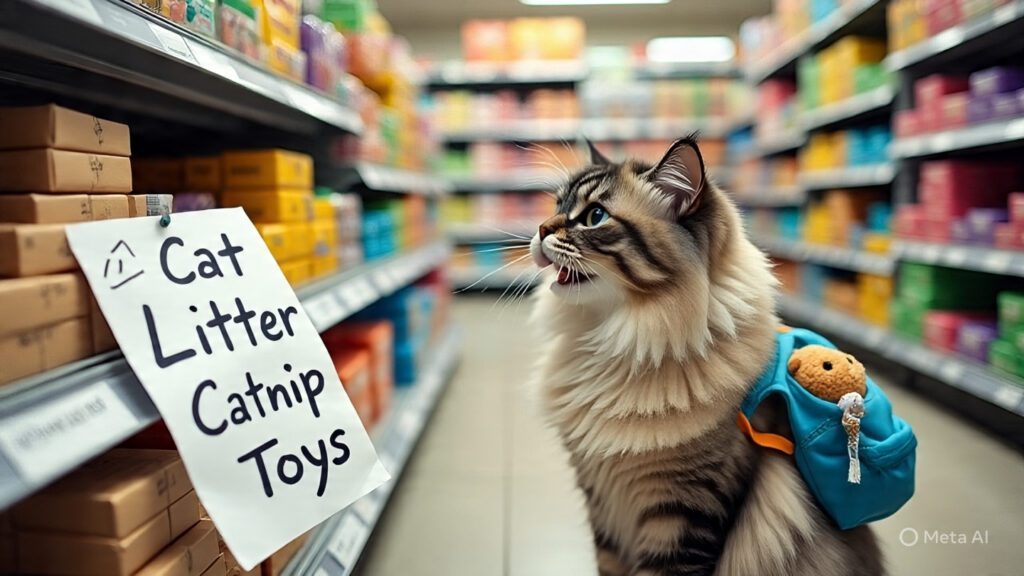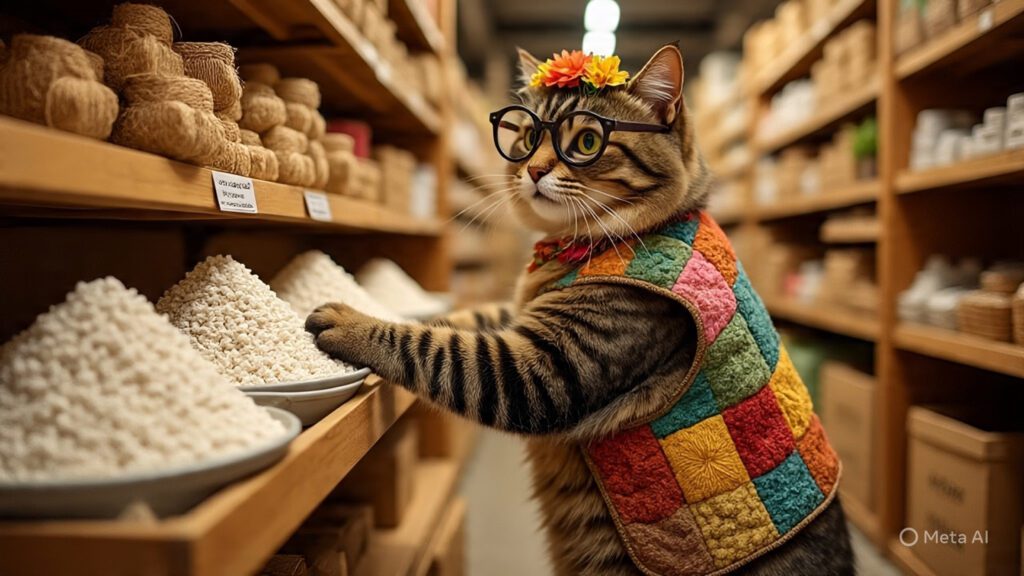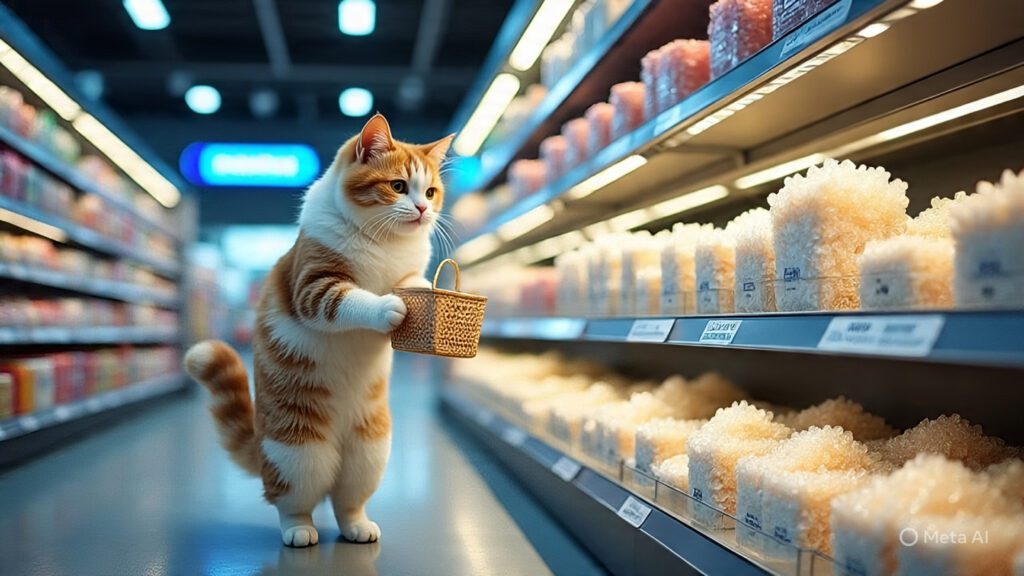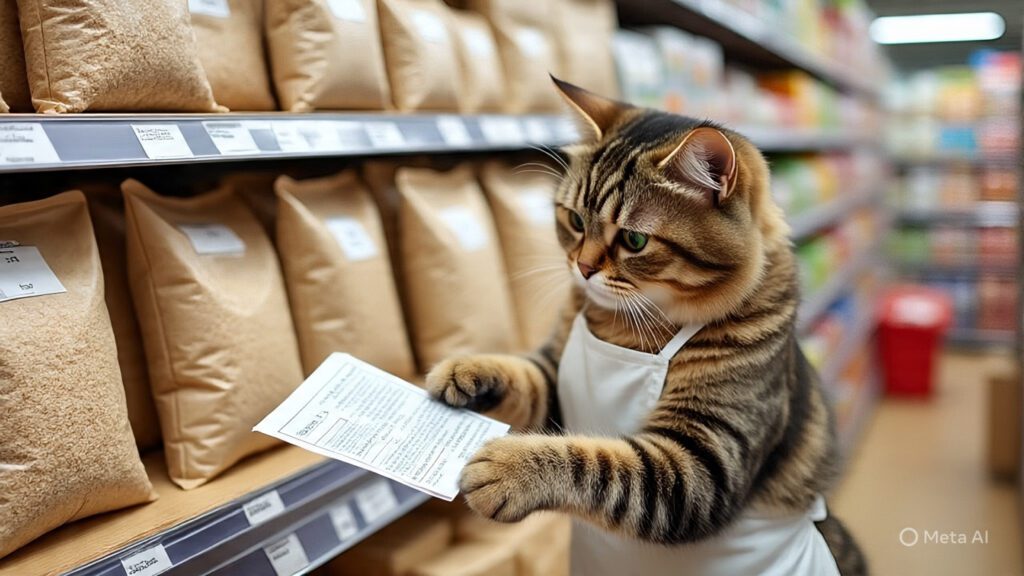Please Note: This post may contain affiliate links. If you click one of them, we may receive a commission at no extra cost to you. As an Amazon Associate, I earn from qualifying purchases.
Choosing the perfect litter for our cats can feel like a high-stakes game of poker. You want to make sure your cat is happy and comfortable, but there are so many choices that it can be hard to decide which one is ideal.
If you've ever stood in front of a whole aisle of cat litter and wondered if you should choose clumping clay or something that sounds like it came from a magical forest, you're not the only one!
Let's look at the different kinds of litter that are out there and talk about their merits and cons.
Top Takeaways and Key Concepts
- Choose clumping or non-clumping clay litter based on your cat’s digging preference.
- Consider biodegradable litters for eco-friendliness and reduced dust, despite higher cost.
- Use crystal litter for long-lasting moisture absorption and low maintenance cleaning.
- Select paper-based litter for kittens or cats with sensitive paws.
- Monitor your cat’s reaction to new litter and adjust type accordingly.
Article Summary
Choosing the right cat litter depends on balancing your cat’s comfort, odor control, ease of cleaning, and environmental concerns. Clay-based litters are popular, with clumping types making cleanup easier, but dust and environmental impact are drawbacks. Biodegradable litters are eco-friendly and low-dust but may require more frequent scooping. Crystal litter absorbs moisture well and reduces cleaning frequency, yet may not suit all cats. Paper-based litters are gentle on sensitive paws but less effective at controlling odor. Ultimately, pet owners should test different types, observe their cat’s preferences, and consider practicality, budget, and environmental impact to find the optimal solution.
Handy Amazon Shopping Directory for Cat Supplies
Cat Food - Cat Toys - Cat Health - Grooming - Carriers - Cat Beds - Apparel
Furniture - Cat Doors - Collars - Feeding/Watering - Flea/Tick Control - Treats
Video Summary
Jump to Content
Clay-Based Litter: The Old Standby

Let's see… clay-based litter has been around longer than most cat owners have had their first cup of coffee in the morning. People typically think of this as “cat litter” because it is stable and familiar. But why is this traditional choice so popular?
To begin with, there are two main types of clay litter: clumping and non-clumping. while you add moisture to clumping clay litter, it forms firm balls that are easy to clean up. It's easier than looking for your car keys while you're running late for work.
Non-clumping cat litters, on the other hand, have their own special features. They do a good job of soaking up liquid waste, but they often leave a mess that looks like a construction site after a storm, with litter grains all over the place and the litter box area looking like a mess. This can be really annoying for pet owners who care about keeping things clean and easy to care for. On the other hand, clumping litters make solid clumps when they get wet, which makes cleaning up every day more easier and quicker.
But it's crucial to remember that certain cats can like non-clumping litters better because of how they feel. Cats naturally like to dig, and non-clumping litter makes it easier for them to do so, which is like how they would act in the wild. Your cat might get cerebral stimulation and satisfaction from digging as they interact with their surroundings.
That being said, there are also some important drawbacks to think about when picking clay-based litters, especially those derived from sodium bentonite clay. Dust is a big problem; these litters can be very dusty when you pour them or utilize them. Imagine that every time your cat steps into her box, she sneezes uncontrollably. That would be a nightmare! If you are sensitive to allergens, the dust can make both your cat's and your own respiratory systems feel bad.
Also, we can't ignore the environmental issues that come with using traditional clay litters. Most clay-based litters arise from strip mining, which destroys habitats and disrupts ecosystems. As more people learn about sustainability, many pet owners are looking for eco-friendly options that are less harmful to the environment but still keep their pets comfortable.
If you care about the environment (and you should), choosing biodegradable or eco-friendly litter may be more in line with your principles. There are many options on the market now that work just as well as traditional litters without harming the environment. These include recycled paper pellets and corn- or wheat-based litters.
In the end, choosing the correct litter means finding a balance between your cat's needs and the needs of the environment. It all comes down to what works best for you and your animal friend when it comes to clumping or non-clumping alternatives. If you take the time to look into different kinds of litter, you may make your cat's bathroom experience more pleasant while also keeping your home clean. After all, happy cats make happy people!
Litter That Breaks Down Naturally: Going Green with Your Cat

Speaking about being eco-friendly, more and more people are using biodegradable litters as they hunt for greener options. These litters are made from corn, wheat, pine, or recycled paper goods, which makes them very environmentally friendly.
One big plus is that biodegradable litters break down naturally over time, so you don't have to deal with the annoying plastic bits that come with regular litters.
Also, a lot of biodegradable cat litters are made to have less dust than clay litters, which is good for both your lungs and your cat's respiratory health! This lower amount of dust can make the air cleaner for both your cat and you, as well as anyone else in the house who might have allergies or sensitivities. A litter that cuts down on dust means you won't have to sneeze and cough as much when you clean the litter box.
But on the other hand, and to be honest, I've noticed that some biodegradable litters don't do as good a job of absorbing smells as regular clay litters do. They can handle wetness very well, but they don't always do a good job of getting rid of smells. If you don't want your home to look like a messy farm, you might have to scoop it out more often to keep bad smells away. This is definitely not the look most homeowners want! No one wants their guests to stroll into their living room and smell something bad.
Also, it's important to remember that these eco-friendly options may cost a little more than regular clay ones, depending on where you live. It's great that you're buying products that are good for the environment, but you should think about whether the extra cost fits into your budget. Some pet owners may have to pick between the benefits of being environmentally friendly and the cost, which is why they choose traditional litters.
When choosing cat litter, the most important thing is to strike the correct balance between performance and being good for the environment. If you want to help the environment while still making your pet's bathroom experience as comfortable as possible, you may need to try out different brands and types of litter to find the one that works best for both smell control and your budget. Every little step toward sustainability matters, so don't be afraid to try out different solutions until you discover one that works for you and your pet.
Crystal Cat Litter: A Shiny Choice

You all probably know about the crystal cat litter, right? The litter that makes it look like your pet had a restroom adventure in space.
The tiny silica crystals in it soak up moisture yet let odors out. Because of this, it also gives cat owners a new way to deal with their trash.
This also helps cut down on the annoying dust clouds that come out when you use regular kitty litter. Plus, it's cheaper because you don't have to change it as often!
Some users say that certain varieties of litter can really last up to two weeks without any care since they are so good at soaking up moisture. This means that busy pet owners won't have to clean the litter box as often, which is a tremendous relief! It sounds like a dream come true to not have to scoop every day and still have a place that doesn't smell too bad.
But here's the bad news: it's not the best choice for every cat or situation. For example, some manufacturers may use materials that aren't as pleasant for your cat. Mittens could like walking on softer granules better than hard crystals or mats that are made to soak up water. This brings up an important point: if she gives you the stink-eye when she goes to her litter box, you might want to think about your choice again! No one wants a cat who is unhappy and thinks her bathroom is more like a prison than a safe place to be.
In these situations, you may need to go back to more traditional solutions, but remember that this change can be hard in its own right. Going back means paying more than you would for other varieties because you're basically buying what feels like diamonds for your cat instead of smart science and technology! Because they are made with special ingredients and formulas that are meant to work best, high-quality litters can be expensive.
It's tempting to choose solutions that are easy to care for, but your cat's comfort and preferences should always come first. In the end, the best way to make your home more peaceful is to find the proper balance between your pet's enjoyment and your own convenience. Keep in mind that it's always worth it to spend money on your cat's comfort because they make us so happy!
Paper-Based Litter: A Soft Place for Paws That Are Sensitive

Let's take one more look at the paper-based litters. They seem like an excellent choice if you have kittens or senior cats with delicate paws.
They are high-quality items created from recycled paper fibers that are chopped up into soft pellets or granules. These pellets or granules perform a good job of getting rid of cat waste without injuring the cats.
One good thing about using paper-based cat litter is that it doesn't hurt the sensitive pads on a cat's feet. And I don't want to compare how it feels to put my toes on a soft, fluffy sheet to how it feels to lie on gravel.
When it comes to figuring out how a cat does its thing during toilet breaks, the huge variances between types of litter are very important. Not only may the type of litter you choose affect your cat's comfort, but it can also affect how clean and smell-free your home is. For example, paper-based products are very absorbent, so minor spills don't turn into big pools. This makes them a popular choice for many pet owners. They can keep moisture in and make your cat's space clean.
On the other hand, paper-based products have one big shortcoming that causes many owners think twice before converting from more traditional options like glass beads or clay: they can't regulate smell. They are good at soaking up liquids, but they don't always do a good job of getting rid of bad smells. And I can tell this without a doubt: no one likes the bad smell that stays in a closed environment, especially one in your home. A bad fragrance can ruin the mood for both you and your guests!
Also, it's important to remember that not all cats will like utilizing litter made of paper. Some cats, especially kittens or those with certain tastes, might prefer to bury their poop in soil-like substances. This instinctive habit comes from their natural proclivities. Cats usually feel more at ease in places that are similar to what they would find in the wild.
Also, if a cat doesn't like the texture or smell of a certain sort of litter, it might not use the litter box at all, which could lead to accidents around the house. This is not only annoying, but it could also make you and your pet stressed.
In short, paper-based litters have certain pros, like being absorbent and causing less mess when spilled. However, they also have some cons, like not being able to manage odors well and cats having different preferences. Before making a switch, you should carefully consider these pros and cons. After you give your cat a new type of litter, it's always a good idea to watch how they act closely to make sure it satisfies their needs and keeps your home clean and friendly.
Last Thoughts
Ultimately, the sort of litter you choose depends on what you like and what works best for your lifestyle and your cat's needs. There are many different types of litter on the market, from traditional clay and crystal types to newer biodegradable ones. Pet owners need to figure out which one is best for them.
For a lot of people, practicality is the most important thing. This covers things like how easy it is to clean, how well it controls odors, how much it absorbs, and how often they need to scoop or change the litter. For example, people who like rapid clean-up periods might prefer clumping litters since they create solid clumps when wet, which makes it easier to get rid of waste without having to clean the whole litter box. Some owners, on the other hand, may choose eco-friendly choices manufactured from recycled materials or plant-based compounds above convenience, even if it means having to do more work to keep them clean.
It's also crucial to think about what your cat likes. Cats are known for being picky, and they may be very picky about how they use the restroom. Some cats could like softer granules that let them dig and bury their waste easily, while others might like the feel of bigger crystals or even paper-based litter. Watching how your cat acts after you give them a new kind of litter might help you figure out if they've accepted it or if you need to make changes.
Also, the budget is a big part of this decision-making process. Some high-end brands may do a great job of controlling odors and soaking up moisture, but they cost more than regular clay litters. Pet owners need to think about these expenditures and how much they are willing to spend on a product that satisfies both their needs and those of their cats.
There is no one-size-fits-all answer to the question of what type of kitty litter to use. It really depends on what each person likes and what works best for them. The priorities of each pet owner will be different depending on where they live, how much money they have, how much they care about the environment, and how well they know their cat's habits. So, as a responsible pet owner, you should try out different kinds of litter until you find the one that works best for you and your furry companion. This is also a chance to learn something new along the way!
Suggested Resources:
Understanding Cat Litter Types
https://www.catlovers.com/understanding-cat-litter-types
Best Cat Litters Reviewed
https://www.petmd.com/cat/best-cat-litters-reviewed
How To Choose the Right Cat Litter
https://www.thesprucepets.com/choose-the-right-cat-litter-554205
Frequently Asked Questions
Is clumping clay litter easier to maintain than non-clumping?
Clumping litter forms solid waste clumps that are simpler to scoop daily, while non-clumping absorbs liquid but can leave more leftover residue in the box.
Are biodegradable litters safer for the environment?
Biodegradable litters break down naturally and usually produce less dust, but they can cost more and may require more frequent scooping to control odor.
Does crystal litter help reduce litter box odor?
Crystal litter absorbs moisture extremely well and can reduce odor for longer periods, though not every cat enjoys the texture of silica crystals.
Is paper-based litter good for kittens?
Paper-based litter is soft, gentle, and low dust, making it a good option for kittens or cats with sensitive paws, though odor control can be weaker.
How do I know which litter my cat prefers?
Observe behavior after switching—if your cat avoids the box, seems hesitant, or eliminates elsewhere, they may dislike the texture or scent.
Is clay litter more affordable than other options?
Clay litter is often the most budget-friendly choice, but it produces more dust and has greater environmental impact due to strip mining.
Should I switch litter types slowly?
Gradual switching is best, as mixing new litter with the old one helps cats adjust and reduces the chance of litter box avoidance.

Kevin Collier is a dedicated feline enthusiast and expert contributor at CatFAQ.com, where he shares his knowledge on cat health, training, and overall well-being. With years of experience caring for and studying cats, Kevin provides insightful tips and practical advice to help cat owners nurture and understand their pets better. His passion for enhancing the human-animal bond shines through in his articles, making them a valuable resource for anyone looking to improve their cat’s quality of life. Whether it’s training techniques or health care tips, Kevin aims to empower cat owners with the information they need to ensure their furry companions thrive.

